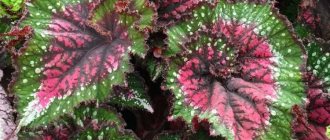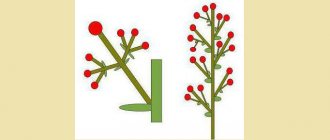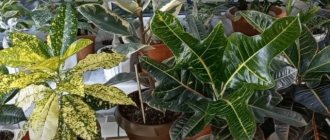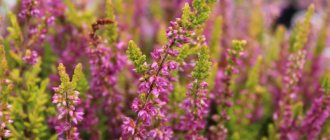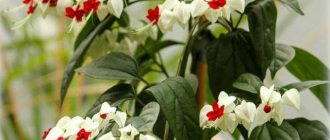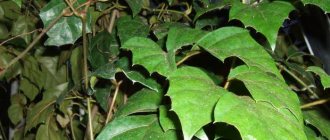Achimenes are one of the most beautiful plants. They are distinguished by a variety of shapes, colors of leaves and flowers. A feature of Achimenes is that they can only be propagated by rhizomes. What it is? This plant does not have tubers, but it does have rhizomes. What it is? They are modified, shortened shoots covered with scales. In essence, Achimenes rhizomes are peculiar seeds that ripen on the rhizome and lower part of the stem. Outwardly, they look like birch earrings. In our article we will tell you how to plant Achimenes rhizomes.
Using hedgehogs to process potatoes
Types of seedling cassettes and their use
Hazelnut - how it grows and blooms, growing a nut in the garden
Types of Achimenes
Many types of Achimenes are common in floriculture, including:
- White Achimenes (Achimenes candida) – 20-45 cm high, green or red shoots; blooms in summer, flowers 1-1.5 cm in diameter, creamy white, reddish on the outside, yellowish at the throat, with red stripes.
- Achimenes ehrenbergii - up to 45 cm high, shoots and leaves are densely pubescent; blooms in summer and autumn, large flowers up to 2.5 cm in diameter, lilac-pink outside and purple inside with a yellow throat, with orange spots.
- Achimenes erecta - 25-45 cm high, reddish shoots; blooms in summer, flowers up to 1 cm in diameter, scarlet-red.
- Achimenes heterophylla - up to 30 cm tall, with purple stems; blooms profusely in summer and autumn, the flowers are large (5 cm), the corolla tube is fiery red 3 cm, with an expanded yellow throat, spotted.
- Long-flowered Achimenes (Achimenes longiflora) – 10-30 cm high, green or red stems; blooms in summer, the flowers are large (5.5-6.5 cm) blue or bluish-purple, sometimes pink and less often white, the throat is yellow.
- Achimenes prostrate (Achimenes patens) - about 30 cm high, has green or brown stems; blooms in summer, single lilac flowers 1.5-2 cm, corolla tube widened upward, with a spur at the base.
- Fringed Achimenes (Achimenes fimbriata) – up to 30 cm high with erect drooping stems; white flowers with fringed corolla edges.
- Mexican Achimenes (Achimenes mexicana) - has weakly branching shoots 35-50 cm high; It blooms in summer and autumn, large flowers are lilac with a white throat, as well as white, pink, and purple. This species and its forms with showy flowers are most often found in the collections of gardeners.
Autumn preparation of rhizomes for storage
In autumn, when it’s time to rest:
- Achimenes stops forming new buds;
- the plant does not produce a noticeable increase in the green part;
- the foliage, starting from the lower tiers, withers;
- The soil, due to the plant’s lower need for moisture, remains wet longer.
Having noticed the first signs of the end of the growing season, the grower should stop feeding Achimenes and begin to reduce watering. If this is not done, the rhizomes of Achimenes may go into winter spoiled or with unformed growth points and scales.
The preparation of Achimenes rhizomes for storage is facilitated not only by reducing watering and eliminating fertilizers, but also by a natural reduction in daylight hours, as well as a decrease in air temperature. If Achimenes is grown in a room where the daytime temperature is close to 30 °C, and at night it decreases by no more than 5–7 °C, the process of transition to the dormant period in plants is delayed. Such specimens completely stop watering to provoke the death of foliage and shoots.
To ensure that the rhizomes survive the winter more easily, and that the rhizomes do not dry out or begin to rot during storage, it is better to wait for the above-ground part of the plant to completely dry out and only then send it into its many-month “hibernation.”
When to plant Achimenes rhizomes
When is the best time to plant rhizome achimenes? The optimal period is the end of February-end of April. The specific planting time depends on your conditions. It is necessary to understand that already in the initial period of growth the plant will need good lighting. At the initial stage, artificial lighting (special lamps for plants or simply fluorescent lamps) can help. If you do not have this opportunity, northern shaded windows, it is better to postpone planting to a later date, adjusting the storage temperature to a cooler one (but not lower than 12 degrees) to prevent earlier germination of rhizomes.
ACHIMENES - HOW TO PLANT RHIZOMES
1. Take a sprouted rhizome. If you purchased a new variety, then as a rule it will come to you in a bag like this in vermiculite.
2. Place the rhizome horizontally on the ground, preferably (if there is only one) in the middle of the pot.
3. (optional) You can pour out the vermiculite in which it was stored, in case it contains microcups that can also germinate.
4. Sprinkle the rhizome(s) with a small layer of soil (1.5-2 cm)
5. Water the planted rhizome; only light moisture is needed, no more.
6. We sign the variety, if necessary.
7. Place in a bright place (under lamps in the photo) and wait for sprouts. You can lightly moisturize once a week.
HOW MANY RHIZOMES DO YOU NEED PER POTA?
There are different recommendations regarding the number of rhizomes needed to create beautiful lush blooms. We can say that everything here is quite relative and depends largely on the variety and growing conditions. For example, many modern varieties, subject to agricultural technology, show very good results even when planting 1 rhizome per pot with a diameter of 10-11 cm. Others, on the contrary, require dense planting of 3-4 rhizomes per the same pot. Romanian collector Serge Saliba uses the following formula for himself: 5 rhizomes per 16.5 cm pot, while additionally devoting time to timely pinching of growing Achimenes to ensure good branching.
HOW LONG DOES ACHIMENES GROW UP?
As a rule, 1.5-3 weeks after planting you will see green Achimenes. The germination period depends on the initial length of the sprouts (rhisomes with slightly “bent” sprouts germinate a little slower than those planted with rather long shoots) and temperature (low temperature will slow down the germination period, high temperature will speed it up).
THE ACHIMENES WOKE UP EARLY - WHAT TO DO?
Early harvesting of rhizomes for storage (August-September), high storage temperatures can provoke early germination of rhizomes (November, December, January). What to do with such rhizomes? There are several ways to solve this problem:
- Plant rhizomes, providing additional lighting so that the sprouts do not stretch out. It is advisable that daylight hours be 12-16 hours. However, when choosing this option, be prepared for the fact that the growing season will also shift and the plant will retire (dry out) earlier than usual.
- Reduce storage temperature. This option is suitable if the shoots of the rhizome are not too long. Rhizomes can “wait” for planting for 3-6 weeks (depending on the storage temperature and the initial length of the sprout).
- Cut off the sprout and store the rhizomes further for storage. This option is suitable for healthy, large rhizomes. In this case, after some time the rhizome will produce one or more replacement shoots. It is better not to expose small or problematic rhizomes to this risk.
[/vc_row]
Want to add to your collection of achimenes? Choose :
Nocturne
200 rub.
Article: 150out of stock Nocturne (“Nocturne”) The most luxurious, very dark shade ... Read more
Add to Wishlist
Product added! Go to wishlist
The product is already in the wishlist Go to wishlist
Pulcherrima
80 rub.
Article: 177out of stock Pulcherrima (“Pulkerima”) From the Latin name of this ... Read more
Add to Wishlist
Product added! Go to wishlist
The product is already in the wishlist Go to wishlist
DiscountDouble Pink Rose
300 rub.
250 rub. Article: 68out of stock Double Pink Rose (“Double Pink ... Read more
Add to Wishlist
Product added! Go to wishlist
The product is already in the wishlist Go to wishlist
Ambroise Verschaffelt
250 rub.
Article: 6out of stock Ambroise Verschaffelt (Ambroise Vershafelt) Named in … Read more
Add to Wishlist
Product added! Go to wishlist
The product is already in the wishlist Go to wishlist
1 review
5.00 out of 5
Simbirochka
180 rub.
Article: 214out of stock Simbirochka (“Simbirochka”) Ruddy hybrid with large ... Read more
Add to Wishlist
Product added! Go to wishlist
The product is already in the wishlist Go to wishlist
Glory
140 rub.
Article: 91out of stock Glory Compact and at the same time very ... Read more
Add to Wishlist
Product added! Go to wishlist
The product is already in the wishlist Go to wishlist
Snoweetta
200 rub.
Article: 217out of stock Achimenec Snowetta (“Snowita”) Very attractive and unpretentious… Read more
Add to Wishlist
Product added! Go to wishlist
The product is already in the wishlist Go to wishlist
Planting Achimenes rhizomes
A well-formed, strong sprout can be observed in an Achimenes rhizome suitable for planting. The lower the storage temperature of the rhizomes, the later they wake up. If the rhizome of Achimenes has already begun to grow, it will not be possible to stop it, but development can be slowed down by placing such a rhizome in a cooler room with a temperature of at least 10–12 °C.
You should not abuse the plant’s patience, since in such conditions Achimenes grows weakened, and thin elongated shoots are easy to break off during subsequent planting.
Depending on the size of the rhizomes, the diameter of the selected pot and the variety being grown, 5–10 rhizomes are planted in one pot. For achimenes with a shallow root system, it is better to select containers that are not too deep, but do not forget about the drainage layer.
Achimenes rhizomes are laid out on the surface of a moist substrate, and another layer of soil 1.5 to 2 cm thick is made on top.
After planting, Achimenes rhizomes are again watered moderately, trying not to wash away the soil layer. The pot with the future flower is placed in a well-lit place, and additional lighting is provided in early spring.
In the future, moderate soil moisture will be required. From the moment Achimenes rhizomes are planted until the sprouts appear, it takes from one and a half to three weeks.
How to determine whether rhizomes are ready for planting?
The rhizome, ready for planting, has formed a sprout. Its length can be from a few millimeters to several centimeters. If rhizome sprouts are available, you can plant them. At the same time, you can take your time with landing.
When should they be planted? Rhizomes do not fall off for a month after they ripen. So you can always wait for the optimal landing time. Experienced gardeners do not grow rhizomes that are too long, because they can be easily broken when planted. By the way, a broken rhizome still germinates, but only with a two-week delay.
Caring for Achimenes
When the sprouts appear and begin to develop, the protective cap is removed and normal plant care begins. It consists of regular watering, spraying the room, loosening the soil in the pot and applying fertilizing (mullein, mineral complexes). Flowering usually occurs four months after the rhizomes are placed in the soil. During the flowering period, fertilizing becomes more frequent.
Planting leaf celery for seedlings
Planting pepper seedlings in the Moscow region
Black bunch tomatoes
If you want to increase the bushiness of the plant, the tops of young shoots need to be pinched. On faded stems, the tops are also removed to form side shoots with new buds.
To make plants bush better, pinch the tops of young shoots and those stems that have already bloomed. This will cause new shoots to appear on the side and fresh flowers to appear on them. Do not forget to remove dried inflorescences to allow new flowers to form in their place.
Reproduction of Achimenes:
Achimenes candida.
The plant reproduces by daughter rhizomes, which Achimenes forms from 3 to 10 pieces per year. This method is the easiest and most effective; it allows you to obtain new plant specimens immediately during the planting season. If the plant spent a dormant period in a pot, propagation is carried out before the growing season in the spring, then the rhizomes are dug up and divided into other pots. If you want to get many daughter plants, you can divide the rhizome into 2-3 parts, treating the cut areas with charcoal.
Achimenes can also be propagated by cuttings in May-June, no later than August, since then the annual rhythms of the plant can become very disrupted. To do this, young shoots must be cut into cuttings 8-12 cm long. They must have at least 1-2 internodes. Root the cuttings in a glass of water with the addition of activated carbon or in the ground under a cover. Rhizomes appear within 2-3 months after rooting.
Achimenes rest period
By autumn, the flowering of Achimenes ends, its leaves begin to turn yellow and die, and the plant enters the dormant stage. It is necessary to prepare the plant for this period and gradually reduce watering until it stops completely. When the ground part dries out, it is cut off. The rhizomes can be left in the same pot or transferred to the sand. At the same time, they are stored in a dark and cool place all winter at a temperature of 8-16 ° C, occasionally moisturizing. Moisten as the substrate dries, carefully watering the edges of the pot with water at room temperature, no more than once a month. Overwatering during the dormant season can cause the plant to go out of dormancy. As a result, the plant will be weakened and flowering will be weak, since in winter there is not enough light for Achimenes to grow and flower successfully. If for some reason your achimenes have come out of the dormant period, you can create additional illumination for them using fluorescent lamps, placing them above the plant at a distance of 30-50 cm.
Achimenes - home care
Close relatives of Achimenes are decorative houseplants Saintpaulia and Gloxinia. These flowers do not live in nature in the European climate; they are aliens from the South American tropical forests. Mature flowerpots grow in the form of branched bushes with drooping or creeping stems covered with soft, pubescent leaves. There are compact, upright forms of Achimenes that are perfect for indoor growing.
The main advantage of Achimenes is that the care and cultivation of these flowerpots does not require special equipment or high costs from the owner. At home, they delight with long-lasting flowering, when the bushes are abundantly decorated with beautiful bells of various colors. The petals of Achimenes can be bright or dark, plain or spotted, with decorative stripes. The flowering period lasts from May to cold October in two stages and ends in a state of dormancy with the complete death of the aboveground part.
Achimenes - care
These flowers are not distinguished by their capricious disposition, they reproduce easily and are able to forgive minor mistakes for beginners. When solving the problem of how to care for Achimenes at home, you will not have to spend precious time on your pets in winter. These plants, like gloxinias, dry out and are stored in any dark, secluded place until spring, without causing unnecessary trouble to humans.
The main rules for growing Achimenes:
- An important point is that Achimenes prefer to be cared for and grown in good but diffused natural light, so it is advisable for them to have window sills facing the west or east. On southern or south-eastern windows it is necessary to shade pots and flowerpots.
- In small containers up to 0.7 liters, plants will bloom sparingly; as they grow, immediately transfer the bush into a spacious container.
- Watering is moderate; drought and overwatering are equally harmful to Achimenes.
- We humidify the air periodically, but without directly spraying the flowerpot, this procedure causes stains on the leaf plates.
- We provide mineral fertilizing every 1-2 weeks.
- In winter, watering is kept to a minimum.
- The stems should die off on their own, the above-ground mass is cut out after complete drying.
How to store Achimenes rhizomes in winter
At this time, reduce watering, and then stop altogether. The leaves of the plant soon begin to wither and dry out. When the entire above-ground part of the plant is completely dry, cut it down to the base.
After this, move the pot with achimenes to a cool, dark place with an air temperature of 16 to 18 degrees. During the hibernation period, you can lightly moisten the top layer of soil in the pot once a month. You can also sort the planting material into transparent resealable bags depending on the variety. Vermiculite and perlite provide good storage.
Life cycle of Achimenes
Achimenes has a pronounced dormant period, during which the plant completely stops all its vital activity. The dormant period cannot be bypassed in any way and it is impossible to force the rhizome to grow by any means; all rhythms are regulated only by the plant itself. The dormant period usually occurs in autumn-winter and lasts from 4 to 6 months, it all depends on the plant variety and storage conditions.
Achimenes dulcis.
Autumn. Achimenes is preparing to go into hibernation, flowering stops, and buds stop setting. The leaves on the plant begin to dry out and turn yellow; as a rule, this process begins with the lowest foliage; rusty spots may begin to appear. In Achimenes pots, the soil begins to dry out more slowly, as all processes slow down. During this period, it is necessary to begin to reduce watering and stop applying fertilizers, waiting until the achimenes has completely shed all its foliage. If your plant has not entered the dormant period before November, you need to speed up this process by completely stopping watering. This method can only be used for plants that have been grown for more than 3 months, otherwise it may turn out that the rhizomes have not had time to form.
Winter and spring. The dormant period of the plant, when all the leaf mass and rhizomes can be removed for storage. There are several ways to store Achimenes rhizomes:
- Way. Storage in a pot in which Achimenes grew. In this case, the pot is placed in a cool, dark place and stored without watering until spring. This storage method has both its pros and cons. The disadvantages include the pots themselves, they take up too much space, but the advantages are that rhizomes stored in the ground ripen better. This method is great for those who do not have a very large collection and have somewhere to store pots of rhizomes. In spring, the pot is placed again in a well-lit place, sprinkled with fresh soil on top. If you want to propagate Achimenes, then do not wait for the rhizomes to emerge from hibernation and disassemble them earlier. It is better to propagate regularly in order to thin out the achimenes a little and avoid too dense planting.
- Way. Storage in zip bags with filling. After the plant has entered a dormant period, it is necessary to unearth the rhizomes, dry them and place them in a zip bag with dry sand, vermiculite or dry peat. After this, all bags should be removed to a cool, dark place. Rhizomes are stored dry, without watering. When storing in this way, it is necessary to regularly check the bags for the presence of condensation or blackened scales - fungus. If condensation is detected, the bag must be kept open for several days, and if a fungus is detected, the rhizome must be treated with an antifungal agent and separated from healthy ones. Such storage also has its pros and cons, the advantages include the compactness of storage, in which even many copies can be placed in one box, monitoring, when you see and can control the condition of the rhizomes.
The optimal storage temperature for rhizomes is considered to be from 8 to 15 ºC. This temperature will ensure a normal dormant period and prevent early germination.
Achimenes Rose.
If germination did occur earlier, what should be done in this case?
- If the rhizome sprouts are not too long and the deviation from the optimal planting time is small, you can reduce the storage temperature. In this case, the rhizome can wait 1 month.
- Plant rhizomes. This method is not very good, since in this case the growing season will be mixed up, the plant will go to rest earlier and will wake up at the same time next season. The disadvantages include the need for additional daylight for up to 12 hours, which is a prerequisite for obtaining a strong and beautiful plant.
- If the rhizome is strong, large and healthy, you can tear off the sprout and lower the temperature and store it further. After some time, the rhizome will again sprout a new shoot, maybe several.
Pests and common problems
Achimenes can be attacked by mealybugs, aphids, whiteflies , and spider mites. If uninvited guests are detected, the flower should be treated with insecticides.
Due to prolonged high humidity and sudden temperature changes, Achimenes can become infected with gray mold . To cure a plant, you need to remove the affected stems and leaves, change the soil in the pot and treat it with fungicides.
- spots on the leaves - watering with cold water, drafts and too bright sun;
- leaves turn yellow - hard water for irrigation;
- flower buds turn brown - dry and hot air in the room.
For recommendations from professionals on how to prepare Achimenes for winter at home, watch the video:
Growing charming achimenes at home is not at all difficult. It just requires a little attention and care. In return, Achimenes will give immeasurably more - a luxurious bouquet of bright flowers, a riot of lush greenery and a powerful charge of positivity.
Planting a plant
A plant germinated in a glass must be planted in a pot as carefully as possible. If possible, it is better to move the flower along with the soil in which it grew. Select pots that are shallow but wide. From one to 5-7 sprouts are planted in one container, depending on the volume of the pot. To grow achimenes in pots without prior germination, choose the same flat, wide containers. A plant with shallow rhizomes does not like deep planting. Rhizomes are planted as follows.
- Begin to complete the flower pot with drainage. Achimenes do not tolerate accumulation of dampness; drainage is necessary for them.
- Having placed a little sand and crushed stone on the bottom of the container, it is covered more than two-thirds with earth. The soil should contain peat, be loose and moist.
- Rhizomes are laid out on the surface in a horizontal position, their number depends on the volume of the pot.
- Planting material is covered with a layer of soil of 2-3 centimeters.
- If the soil is not moist enough, lightly water with warm water.
- The pots are transferred to a warm, bright place, covered with cellophane or glass, creating a greenhouse effect.
Landing completed. Next, you need to monitor humidity and temperature conditions. Plants grow well at temperatures of 20-27 degrees. When the achimenes begin to rise, they will need illumination for at least 16 hours a day; in the evenings, lamps should be left on for them.
How to dig up rhizomes and prepare for storage
Achimenes can be left in a pot without digging up the rhizomes, and in the spring it will wake up again. But if you want to save space, plant a flower in the future and get several plants, then the best solution is to dig them up.
Rhizomes are easily stored dry in zip bags in vermiculite, which is undoubtedly convenient and compact. Thus, a huge collection of different varieties can fit in just one small box.
In addition, rhizomes in bags do not require watering at all. They dug it up, put it away and forgot about it. We remembered only in the spring.
It should be noted that flower growers who are fond of Achimenes get special pleasure from digging up rhizomes and often compare this process with harvesting. Because while the plant is in a pot, it is unknown what rhizomes and how many of them it managed to grow during the period of growth and flowering.
Description and types
Native to the tropical forests of South and Central America, Achimenes belongs to the perennial shrubs of the Gesneriaceae family. Its genus includes 30 species, among which you can find bushes and hanging ones, hanging in a beautiful cascade of shape.
On the slightly pubescent straight or branching shoots of Achimenes there are serrated shiny leaves covered with small, stiff hairs .
flowers of a rare elongated shape , similar to bells, give the plant a special attractiveness They grow along the entire length of the stem from the axils of the leaves and during the flowering period they cover the entire bush with a thick, bright head of flowers.
Among the plant varieties you can see white, blue, purple, pink, red, yellow, burgundy and unusual shades in between. Achimenes flowers quickly fall off, but new buds immediately begin to bloom to replace them.
Among the many types of Achimenes, several of the most popular varieties stand out:
- Achimenes longiflora “Chiapas” with light purple flowers and “Juaregia” with white flowers decorated with a lilac spot in the middle are very beautiful
- Achimenes grandiflora is the largest species of Achimenes. The upper part of its leaves is dark green, and the lower part is purple-red. Its carmine-pink flowers are no less beautiful.
- Achimenes fimbriata - blooms with beautiful white flowers with fringed edges.
- Hybrid Achimenes (Achimenes hubridia) - includes many varieties with a wide variety of flower colors: “Yellow Beauty” - yellow, “Schneewitschen” - white, “Master Ingram” - red, “Purple King” - purple, “Rose Pink” and “Beauty” is pink, “Ambroise Verschaffelt” is white with thin purple veins.
The plant blooms from spring to autumn. During the season, Achimenes accumulates nutrients in rhizomes ( rhisomes ), which do not require light or care during the dormant period. It winters well in some secluded place under the bed, in a closet or garage.
Admire the variety of types, colors and shapes of Achimenes in the video below:

